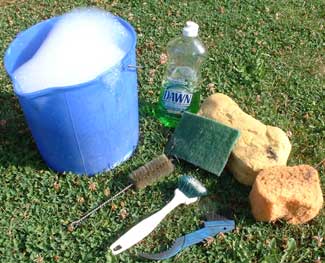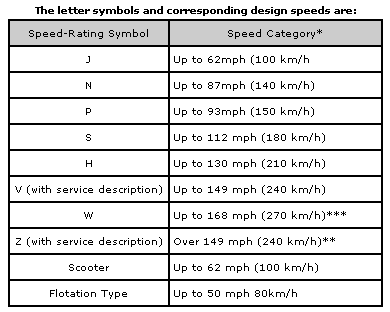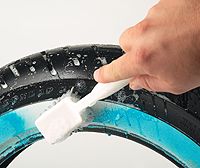
Motorcycle Tire/Tyre
Maintenance Guide
Motorcycle Tire/Tyre Maintenance tips to keep your motorcycle at peak condition.

A bucket of water, a little soap and some elbow grease go a long way to keep your tires in top exterior proformance and they look clean and new too.
Motorcycle Tire, Tyre Maintenance
Fixing a flat – Plugging a flat tubeless tire
(Credit to Carolyn from Blueproof, all images and text used with permission)
What you’ll need:
Tire repair kit
Scissors
Time needed: a half-hour or so, but assume longer if you’re on the side of the road somewhere in the pouring rain.
Background.
Flat tires are one of those things that happen when you least expect it. I was lucky; my tire decided to go flat in my own garage.
Please note that this particular procedure is done on a tubeless tire. If your motorcycle has tube tires, the procedure will be different. Don’t go ramming pointy things into a tubed tire.
The kit used here contains many tools for both tubed and tubeless tires. For tubeless tires, you’ll need the strips of plug compound, rubber cement, reamer, and needle-like tool. If done correctly, the plug should hold air in your tire until you can get to a shop for a new tire. This is an emergency — and therefore temporary — plug.
Procedure.
If possible, put the bike up on a stand so that you can spin the punctured tire. If you’re on the side of some highway somewhere with a punctured front tire, you may be a little SOL. Then you’ll just have to add insult to injury and push the bike around.
OK, let’s state the obvious: you need to locate the puncture. If it’s not readily apparant, smear some soapy water around the tire and look for little bubbles. I’ve circled my puncture with chalk here so that it’s painfully obvious.
Once you’ve found the puncture, you’ll need to enlarge it. If you have an emotional attachment to your bike, this part is a little unnerving. You don’t normally want to stab pointy things at your motorcycle bits, and it doesn’t help that the tool is called a “reamer”. But ream you must, until the puncture hole is large enough to accept the needle tool. Unless you want to be there all night, you really have to get into the reaming.
Push and pull and twist and really attack the tire. Yes, it’s very unnerving. Try not to think about it too much.
Now you have a nice, um, reamed hole. Pull off a strip of the plugging compound and thread it through the eye of the needle tool. Smear rubber cement along the strip on both sides. Cover the end of the needle tool, too, for good measure. You’ll want to do this step a little quickly, or you’ll drip cement on yourself and everything else.
Once you’ve got a big drippy mess of cement, shove the needle tool into the tire puncture. Push it all the way in to the handle of the needle tool. Give it a twist and pull it out slowly, until about a half-inch of plugging compound sticks out of the tire.
Cut the strip of compound and remove the needle tool. Trim the remaining compound down so that about a quarter-inch remains sticking out from the tire.
Spin the tire so that the puncture is facing down to the floor. This’ll make any cement puddle up around the puncture hole and will help to seal it. Let the cement harden before riding on it. I let my tire sit overnight, but obviously, that won’t be practical if you’re on the side of the road somewhere; use your best judgment.
If your tire lost all of its air, you’ll need to inflate it before trying to ride. My tire kit came with CO2 cartridges, but I didn’t use them as my flat happened about 2.5 feet from my air compressor. If you do need to use the CO2 cartridges, the Stop & Go tire repair kit includes instructions on using them to fill your tire. I used the air compressor to inflate the tire to its recommended 36psi; two days later, the tire pressure still read 36psi. I didn’t check the tire again after getting to the shop, but it didn’t seem wobbly at all on the ride over.
When you do ride on the tire, be careful. Remember: it’s a temporary plug that’s only meant to get you to a shop for a new tire. I have no data on what speeds or distances are reasonable. I personally rode for 4.5 uneventful miles, with a top speed of 50mph, on the pictured plug.
Tire Speed Ratings
Some tires bear a letter “speed rating” designation indicating the tire’s design speed capability. This speed rating system is intended to allow you to compare the speed capabilities of tires.
When purchasing or replacing speed-rated tires, make sure to:
Use the rankings in the chart below to compare the speed ratings of all the tires, and
follow the motorcycle manufacturer’s recommendations, if any, concerning the use of speed-rated tires.
To avoid reducing the speed capability of the motorcycle, replace a speed-rated tire only with another tire having at least the same speed rating. Remember, it’s the “top speed” of the “slowest” tire on the vehicle, which cannot be exceeded without risk of tire failure. The letter symbols and corresponding design speeds are: Speed-Rating Symbol Speed Category*

* In laboratory tests that relate directly to highway speeds.
Reminder: Actual tire speed and performance capability depends on factors such as inflation pressure, load, tire condition, wear and driving conditions.
** Although no upper limit speed is specified here, the indicated tires nonetheless have limited rated speed capability. Call 1-800-367-3872 for a referral for more technical information.
*** Any tire with a speed capability above 149 mph (240 kph) can, at the tire manufacturer’s option, include a “Z” in the size designation (120/70ZR17). If a service description IS NOT included, the tire manufacturer must be consulted for the maximum speed capability. If a service description is included with the size description, the speed capability is limited by the speed symbol in the service description.
Tire Spinning
Spinning a tire to remove a motorcycle stuck in mud, ice, snow, or wet grass can be dangerous. A tire spinning at a speedometer reading above 35 miles per hour (55 km/h) can in a matter of seconds reach a speed capable of disintegrating a tire with explosive force. Under some conditions, a tire may be spinning at a speed twice that shown on the speedometer. This could cause serious personal injury or death to a bystander or passenger and extensive motorcycle damage. Never spin a tire above a speedometer reading of 35 mph (55 km/h).
Wheel Spokes / Wire Wheels
Regularly inspect the spokes of your motorcycle wheels. Broken or loose spokes may cause wheel wobble, which can lead to instability and premature tire wear. Check rim tape condition. A protruding spoke can damage a tube and cause a tire puncture.
Tire and/or Vehicle Storage
Tires and/or vehicles should be stored indoors in a cool dry place where water cannot collect inside the tires. The tires and or vehicles should be placed away from electric generators and motors and sources of heat such as hot pipes. Storage surfaces should be clean and free of grease, gasoline, or other substances, which can deteriorate the rubber. Improper storage can damage your tires in ways that may not be visible and can lead to serious personal injury or death.
Oil, Grease and Gasoline
These items can deteriorate rubber when exposed to a tire for any length of time. Use a clean, damp cloth to remove these chemicals from the tire.
Sidewall Treatment

Use a mild soap solution to clean sidewalls, white stripes or raised white lettering, and then rinse off with plain water. Never apply any other materials, cleaners or dressings to enhance sidewall appearance. These items may degrade the rubber and remove inherent ozone cracking and weather checking resistance.
MOTORCYCLE TIRE CONVERSION CHARTS
|
FRONT TIRES |
||
|
METRIC
|
ALPHA
|
INCH
|
|
80/90
|
MH90
|
2.50/2.75
|
|
90/90
|
MJ90
|
2.75/3.00
|
|
100/90
|
MM90
|
3.25/3.50
|
|
110/90
|
MM90
|
3.75/4.00
|
|
120/80
|
——
|
4.25/4.50
|
|
120/90
|
MR90
|
4.25/4.50
|
|
130/90
|
MT90
|
5.00/5.10
|
|
REAR TIRES |
||
|
METRIC
|
ALPHA
|
INCH
|
|
110/90
|
MN90
|
3.75/4.25
|
|
120/80
|
MP85
|
4.50/4.75
|
|
120/90
|
MP85
|
4.50/4.75
|
|
130/80
|
——
|
5.00/5.10
|
|
130/90
|
MT90
|
5.00/5.10
|
|
140/80
|
——
|
5.50/6.00
|
|
140/90
|
MU90
|
5.50/6.00
|
|
150/80
|
MV85
|
6.00/6.25
|
|
150/90
|
MV85
|
6.00/6.25
|
What do these terms mean?
Metric designation:
Example: 130/90-16 67 H
130 = Section width of the tire (130 mm)
90 = Aspect ratio (90%) (Section height divided by Section width as a percentage)
16 = Rim diameter (inches)
67 = Load rating (A numerical code which corresponds to the total laod carrying capacity at the speed indicated by the speed symbol)
H = Speed rating (see chart)
Alphabetical designation:
Example: MT90-16 LOAD RANGE B
M = Motorcycle code
T = Tire width code
90 = Aspect ratio (90%)
16 = Rim diameter (inches)
LOAD RANGE B = Load range
Inch designation:
Example: 5.00 H 16 4PR
5.00 = Section width (inches)
H = Speed rating
16 = Rim diameter
4PR = Casing strength (ply rating)


